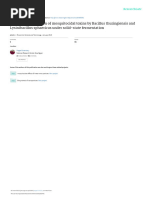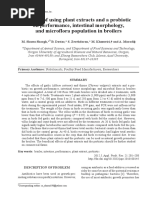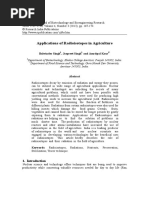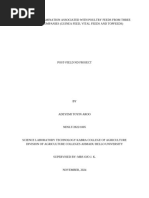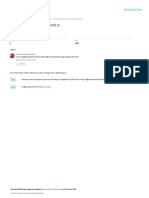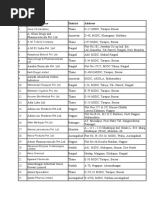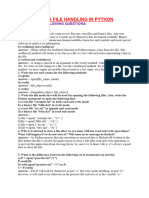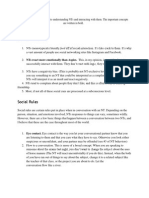Sanitization of Table Eggs With Treatment of Hydrogen Peroxide and Ultraviolet Radiation
Sanitization of Table Eggs With Treatment of Hydrogen Peroxide and Ultraviolet Radiation
Uploaded by
meitaCopyright:
Available Formats
Sanitization of Table Eggs With Treatment of Hydrogen Peroxide and Ultraviolet Radiation
Sanitization of Table Eggs With Treatment of Hydrogen Peroxide and Ultraviolet Radiation
Uploaded by
meitaOriginal Title
Copyright
Available Formats
Share this document
Did you find this document useful?
Is this content inappropriate?
Copyright:
Available Formats
Sanitization of Table Eggs With Treatment of Hydrogen Peroxide and Ultraviolet Radiation
Sanitization of Table Eggs With Treatment of Hydrogen Peroxide and Ultraviolet Radiation
Uploaded by
meitaCopyright:
Available Formats
Vol 10(3) Mar’20
International Journal of Livestock Research eISSN : 2277-1964 NAAS Score -5.36
Original Research
Sanitization of Table Eggs with Treatment of Hydrogen Peroxide and
Ultraviolet Radiation
A. S. Rathod1, R. N. Waghamare2*, V. V. Deshmukh3, M. S. Vaidya4, S. V. Londhe5 and
S. S. Gaikwad6
College of Veterinary and Animal Sciences, (MAFSU) Parbhani, Maharashtra, INDIA
1, 2 & 3
Department of Veterinary Public Health
4
Department of Animal Genetics and Breeding
5
Department of Livestock Products Technology
6
Department of Animal Biotechnology
*Corresponding author: rupeshwaghmare@gmail.com
Rec. Date: Oct 17, 2019 06:33
Accept Date: Feb 15, 2020 10:07
DOI 10.5455/ijlr.20191017063328
Abstract
Use of ultraviolet radiation and hydrogen peroxide for improvement of microbial quality of tables eggs and
assuring safety is under studied in India. Considering this fact in the present study, a total of 432 Table
eggs were procured form local retail markets of Parbhani city and treated with UV radiation at different
exposure time of 1 (UV-1), 2 (UV-2) and 4 (UV-4) minutes alone and with1.5 % H2O2 (HP) and analyzed
for microbial quality of eggshell surface. Efficacy of ‘HP+UV-2’ & ‘HP+UV-4’ treatment was found to be
significant (p<0.05) in reducing total viable count of eggshell surfaces whereas Staphylococcus spp.
contamination was significantly (p<0.05) reduced up to 1.5 log10 cfu by use of ‘HP+UV-4’ treatment.
Comparative effect of various treatments on yeast and mould counts indicated non-significant difference
except for HP+UV-4. The study concluded that the combination of ‘HP+UV-4’ found to be superior than
other treatment groups in enhancing microbial shell surface quality of Table eggs to safeguard the public
health.
Key words: Hydrogen Peroxide, Microbial Quality, Sanitization, Table Eggs, UV Radiation
How to cite: Rathod, A., Waghamare, R., Deshmukh, V., Vaidya, M., Londhe, S., & Gaikwad, S. (2020).
Sanitization of Table Eggs with Treatment of Hydrogen Peroxide and Ultraviolet Radiation. International
Journal of Livestock Research, 10(3), 99-107. doi: 10.5455/ijlr.20191017063328
Introduction
The poultry industry of India has changed dramatically over the last 50 years. Due to the organized efforts
from integrators and farmers the poultry industry has grown and specialized in meat production and egg
99
production. The Indian poultry sector has been one of the fastest growing sectors, with annual growth of
Page
about 8.5 % in eggs and 7.8 % in meat production (GOI, 2019). Egg is considered as proteinous food, which
Hosted@www.ijlr.org DOI 10.5455/ijlr.20191017063328
Vol 10(3) Mar’20
International Journal of Livestock Research eISSN : 2277-1964 NAAS Score -5.36
contain many vitamins and minerals except vitamin C and fully mixed egg contains about 65% water, 12%
proteins and 11% fat (Jay et al., 2005). Many nutrient substances present in eggs create an excellent
environment for the development of bacterial microflora, including pathogenic bacteria (Stepien, 2010).
Egg spoilage is usually associated with freshly and poorly stored eggs owing to poor storage conditions,
like relatively high humidity, which contributes to the high microbial growth. Microbes of egg many cause
severe health problems like diarrhea, nausea and abdominal pain, since they are pathogenic (Ansah et al.,
2009).
In order to achieve the objective of food safety in modern egg production and processing systems,
sanitization of eggs with physical and chemical methods has become a common practice. Combination of
physical and chemical methods should be explored for sanitization of eggshell surfaces mitigating the
negative effects of heat on the functional properties of egg (Favier et al., 2001 and O’bryan et al., 2017).
In order to preserve the microbial quality and reduce the potential for contamination of eggs with pathogenic
microorganism sanitization of the eggshell surfaces during processing at egg production facilities is an
important step. UV light may be lethal to most microorganisms found on eggshell surfaces (Sastry et al.,
2000 and Wells et al., 2010). Similarly, research shows that lower concentrations of H2O2 can effectively
reduce microbial levels from eggshell surfaces (Bayliss and Waites, 1982; Padron, 1995 and Wells et al.,
2010). Morouj et al. (2016) reported that hydrogen peroxide (H2O2) and UV treatment resulted in the
greatest reductions in eggshell aerobic plate counts compared to other treatments throughout egg storage.
Therefore, keeping in view the relative advantages of ultraviolet radiation and hydrogen peroxide in
consideration to safeguard the public health from various pathogens, assuring safety and quality of shell
eggs, the present study was designed with the objective to study effect of hydrogen peroxide along with
and without ultra violet radiation treatment on microbial quality of table eggs.
Materials and Methods
Sample Collection
A total of 432 table eggs comprising of 144 samples (each sample contains 3 eggs) were randomly collected
from different markets of Parbhani city and soon after collection the samples were transported to the
laboratories within one hour under aseptic condition in sterile polybags.
Calculation of Surface Area of Eggs
Weighing of table egg was done for calculation of surface area for estimating Colony Forming Units of
microbial load. A method of Bonnet et al. (1965) modified by Wall et al. (2008) was used for estimating
100
the colony forming units (cfu) as cfu/cm2-
Page
Hosted@www.ijlr.org DOI 10.5455/ijlr.20191017063328
Vol 10(3) Mar’20
International Journal of Livestock Research eISSN : 2277-1964 NAAS Score -5.36
S = 4.68 P (2/3)
Where,
S = surface in cm2, P = egg weight in grams.
Table 1: Design of experiment
Group Number of
S. No. Treatment
Code Samples
1.
C Control without treatment 18
2.
HP Hydrogen peroxide(H2O2) 1.5% 18
3.
UV-1 UV radiation – 1 min exposure 18
4.
UV-2 UV radiation – 2 min exposure 18
5.
UV-4 UV radiation – 4 min exposure 18
6. UV radiation 1 min exposure + Hydrogen peroxide(H2O2)
HP+UV-1 18
1.5%
7. UV radiation 2 min exposure + Hydrogen peroxide (H2O2)
HP+UV-2 18
1.5%
8. UV radiation 4 min exposure + Hydrogen peroxide (H2O2)
HP+UV-4 18
1.5%
Total No. of samples* 144
Total number of eggs collected (144 x 3) 432
Sanitization of eggs with Hydrogen Peroxide (HP) and Ultraviolet (UV) radiation
The table eggs were treated with 1.5 percent Hydrogen peroxide by using Hand sprayer purchased from
local market whereas, for UV treatment kept in cabinet provides 250 nm UV rays where eggs were given
exposure time of 1, 2 and 4 minutes. In UV cabinet eggs were placed in between two UV tubes so that all
surfaces of eggs exposed with UV light. Details of control and treatment group is depicted in Table 1.
Microbial Analysis
Microbial quality of eggshell surfaces of Table eggs with and without treatment with HP and UV radiation
at different exposure time were assessed and evaluated. A method of Musgrove et al. (2005) was used for
collection of eggshell rinsate sample with some modification. Three eggs were aseptically transferred to
sterile polyethylene bag containing 300 ml peptone water. The surface of each egg was gently rubbed
manually through the bag for 1 min. Egg was then removed and transferred to sterile bag separately. Rinsate
was immediately used for estimation of TVC (BAM, 1998) and Differential Count in relation to
101
Staphylococcus spp. (ISO-6888-2: 1999) and Yeast and Mould (ISO-21527-1). Isolation and identification
of Salmonella spp. was done as per the ISO 6579: 1993, Reaffirmed 2005 method.
Page
Hosted@www.ijlr.org DOI 10.5455/ijlr.20191017063328
Vol 10(3) Mar’20
International Journal of Livestock Research eISSN : 2277-1964 NAAS Score -5.36
Results and Discussion
Average Eggshell Surface Area of Collected Samples
The average shell surface area in cm2 of collected egg samples was calculated and results are presented in
Table 2. The average surface area of various treatment groups varied from 45.63±0.40 to 46.10±0.44 cm2
with mean average of 46.070±0.39 cm2. Data pertaining to the surface area of samples was further subjected
to statistical analysis. Average eggshell surface area amongst the different groups of treatment did not differ
significantly. The non-significant difference indicated that eggs from various treatment group and control
were of similar size and did not have effect on microbial load.
Table 2: Details of average shell surface area of Table eggs samples collected under various groups.
Average ± SE (n=3)
S. No.
Group code Weight (grams) Surface area (cm2)
1. C 32.03352±0.47 46.10695±0.44N
2. HP 31.90±0.42 45.987±0.39N
3. UV-1 31.813±0.41 45.90114±0.39N
4. UV-2 31.586±0.37 45.6874±0.35N
5. UV-4 31.580±0.49 45.67269±0.47N
6. HP+UV-1 31.81296±0.42 45.63115±0.40N
7. HP+UV-2 31.58593±0.27 45.77817±0.26N
8. HP+UV-4 31.58019±0.45 45.8492±0.42N
Average 31.99 ±0.41 46.07±0.34
Mean average surface areas do not differ significantly *p<0.05
Effect of Sanitation on Microbial Quality of Eggshell Surfaces
The mean TVC, Staphylococcus spp. and Yeast and Mould counts of eggshell surfaces of Control (‘C’) and
Treatment groups (‘HP’, ‘UV-1’, ‘UV-2’ ‘UV-4’, HP+UV-1’, ‘HP+UV-2’ and ‘HP+UV-4’ ) are given in
Table 3.
Table 3: Comparative analysis of effect of H2O2, UV radiation and H2O2 with UV radiation on microbial
quality of eggshell surface.
Microbial count Group code
(log10 cfu/cm2) C HP UV-1 UV-2 UV-4 HP+UV-1 HP+UV-2 HP+UV-4
TVC 6.331±0.04a 5.883±0.10b 5.629±0.15bc 5.607±0.10bc 5.368±0.14bc 5.596±0.12cd 5.248±0.14de 4.994±0.16e
Staphylococcus
5.303±0.04a 4.574±0.16bc 4.334±0.16cd 4.293±0.15cd 4.111±0.16de 4.67±0.07b 4.209±0.09d 3.801±0.12e
spp.
Yeast and Mould 3.715±0.04a 3.384±0.08bc 3.427±0.09bc 3.505±0.09ab 3.191±0.07c 3.274±0.05c 3.189±0.05c 2.899±0.17d
a, b, c, d, e means with different superscript in a row differ significantly * p < 0.05
102
Page
Hosted@www.ijlr.org DOI 10.5455/ijlr.20191017063328
Vol 10(3) Mar’20
International Journal of Livestock Research eISSN : 2277-1964 NAAS Score -5.36
Total Viable Count
Total viable counts (TVC) of eggshell surfaces given sanitary status at which the eggs are being handled in
farm to retail process. The higher TVC counts indicated unhygienic handling and storage (Gole et al., 2013).
A significantly (p<0.05) higher TVC count was observed in control group as compared to treatment groups.
However, comparisons within UV treatment at various exposure time group indicate non-significant
difference (p<0.05) but lower TVC count in ‘UV-4’ was observed. Significant reduction in TVC count of
eggshell surfaces by UV radiation at 1 to 5 minutes exposure were reported by several research workers
(Kuo et al., 1997; Chavez et al., 2002; Coufal et al., 2003; Patil, 2013 and Melo et al., 2019). UV radiation
in the range of 250 to 260 nm was found to be lethal to various microorganisms including bacteria and
Yeast and Mould (Bintsis et al., 2000; Patil, 2013). The observations in present study indicated that TVC
of eggshell surfaces can be effectively reduced by exposing eggs to UV radiation for 4 minutes. Wells et
al. (2010) also reported 1.5 log10 cfu reductions in TVC of eggshell surfaces after UV radiation (250 nm)
for 4 minutes.
Significantly (p<0.05) lower TVC count was observed in hydrogen peroxide (HP) alone group in
comparison with Control (‘C’) group. Effectiveness of hydrogen peroxide in eliminating eggshell surface
microflora was reported by Sheldon and Brake (1991). Similarly, Wells et al. (2010) reported effectiveness
of 1.5 percent hydrogen peroxide in reduction of bacterial count from eggshell surfaces. In present study
effects were on similar lines in relation with control of shell surface microflora. The comparison of mean
TVC count of groups (‘HP+UV-1’, ‘HP+UV-2’ and ‘HP+UV-4’) indicates significantly (p<0.05) lower
count in ‘HP+UV-4’ group. The results are in agreement with earlier work carried out by Morouj et al.
(2016). The present findings are also in accordance with Woodring (2011) and Wells et al. (2010) where
reduction in total viable counts of eggshell surfaces were recorded 2 to 3 log10 cfu/egg after treating samples
with hydrogen peroxide and UV radiation. In comparison among all groups of experiment (‘HP’ , ‘UV-1’,
‘UV-2’ ‘UV-4’, HP+UV-1’, ‘HP+UV-2’ and ‘HP+UV-4’ ) the efficacy of ‘HP+UV-2’ & ‘HP+UV-4’
treatment was found to be significant (P<0.05) than other treatments in controlling shell surface microflora.
It was also observed that combination of Hydrogen peroxide and UV radiation with exposure time of 2 and
4 minutes were equally effective in reducing total viable count of eggshell surfaces.
Staphylococcus spp.
Staphylococcus spp. is one of the predominant Gram-positive pathogens found on eggshell surface (Ansah
et al., 2009). Significantly (p<0.05) lower count of Staphylococcus spp. was seen on UV treatment group
103
compared to control group; however non-significant difference was observed within UV treatment groups.
Observations indicated that Staphylococcus spp. contamination can be reduced by exposing the eggshell
Page
surfaces to UV radiation for 1 to 4 minutes. The results of present study are not in agreement with study
Hosted@www.ijlr.org DOI 10.5455/ijlr.20191017063328
Vol 10(3) Mar’20
International Journal of Livestock Research eISSN : 2277-1964 NAAS Score -5.36
carried out by Kuo et al. (1997). They did not observe significant reduction in Staphylococcus spp. count
after exposing eggs to UV radiation for 15 minutes. The results are corroboration with earlier studies carried
out by Reu et al. (2006) and Patil (2013). The comparison of ‘C’ and ‘HP’ indicated that eggshell surface
count of Staphylococcus spp. was significantly (p<0.05) lower in ‘HP’ group. Comparatively higher
reduction of Staphylococcus spp. was reported by Maktabi et al. (2018) by using 0.5 percent Hydrogen
peroxide. French et al. (2004) also reported bactericidal effect of hydrogen peroxide on Staphylococcus
aureus isolated from poultry environment. The comparison of mean Staphylococcus spp. count of all groups
(‘C’, ‘HP+UV-1’, ‘HP+UV-2’ and ‘HP+4’) revealed significantly (p<0.05) lower count in ‘HP+UV-4’
group. Current results are in agreement with earlier studies carried out using Hydrogen peroxide or UV
radiation individually or in combination (Reu et al., 2006; Wells et al., 2010; Gottselig, 2011 and Patil,
2013).
In comparison among all groups of experiment (‘HP’ , ‘UV-1’, ‘UV-2’ ‘UV-4’, HP+UV-1’, ‘HP+UV-2’
and ‘HP+UV-4’ ) the efficacy of ‘HP+UV-4’ treatment was found to be significant (P<0.05) than other
treatments which indicated that Staphylococcus spp. contamination could be significantly (p<0.05) reduced
up to 1.5 log10 cfu. It was also observed that ‘UV-4’ and ‘HP+UV-2’ treatment was at par with each other
in control of Staphylococcus spp. contamination.
Yeast and Mould
Yeast and Mould are ubiquitous in nature. Eggs were contaminated because of improper environmental and
storage conditions (Arthur and Somuah, 2001). The yeast and mould count was significantly (p<0.05)
higher in ‘C’ group as compared to other groups of experiment (‘HP’ , ‘UV-1’, ‘UV-2’ ‘UV-4’, HP+UV-
1’, ‘HP+UV-2’ and ‘HP+UV-4’). Within the UV treatment groups ‘UV-4’ group had significantly (p<0.05)
lower count than ‘UV-1’ and ‘UV-2’ group. Results are suggestive of high efficacy of ‘UV-4’ radiation
method in reduction of yeast and mould contamination. Findings of the present study are on similar lines
with earlier work carried out by Kuo et al. (1997) and Patil (2013). Several other workers also used UV
radiation to control yeast and mould growth on food products (Coufal et al., 2003 and Melo et al., 2019).
Eggshell surface count of yeast and mould was significantly (p<0.05) lower in ‘HP’ group than ‘C’ group.
Sheldon and Brake (1991) reported 97.1 percent reduction in yeast and mould count of eggshell surfaces
treated with 5 percent Hydrogen peroxide. Maktabi et al. (2018) reported effect of Hydrogen peroxide on
yeast and mould counts of eggshell surfaces.
The comparison of mean Yeast and Mould count of combination treatment groups (‘C’, ‘HP+UV-1’,
104
‘HP+UV-2’ and ‘HP+4’) reported significantly (p<0.05) lower count in ‘HP+UV-4’ group. Rotem et al.
(1985) reported that UV light was effective in killing fungal spores. Comparison of effect of various
Page
Hosted@www.ijlr.org DOI 10.5455/ijlr.20191017063328
Vol 10(3) Mar’20
International Journal of Livestock Research eISSN : 2277-1964 NAAS Score -5.36
treatments on yeast and mould counts indicates non-significant difference except for HP+UV-4 this shows
superiority of ‘HP+UV-4’ treatment over other treatment groups
Salmonella spp.
In current study none of the eggshell surface sample from Control (‘C’) as well as from all Treatment groups
of experiment were found positive for Salmonella spp. Earlier Berrang et al. (1995); Gao et al. (1997);
Coufal et al. (2003) and Keklik et al. (2010) reported that ultraviolet radiation was safe decontamination
agent for reduction of Salmonella spp. from egg surface. Various researchers reported that Hydrogen
peroxide is effective in reduction of Salmonella spp. from eggshell surfaces (Padron, 1995; Cox et al., 2002
and Buhr et al., 2013). Researchers observed that effectively used Hydrogen peroxide and UV radiation to
reduce Salmonella spp. contamination from eggshell surface (Gottselig, 2011 and Morouj et al., 2016).
Chemical and physical methods are used since long for egg sanitation (Shane and Faust, 1996, Chavez et
al., 2002; Coufal et al., 2003, Reu et al., 2006; Wells et al., 2010; Patil, 2013 and Maktabi et al., 2018).
Conclusion
The findings of this study imply that combination of hydrogen peroxide (1.5% v/v) with UV radiation (4
minutes) is an effective method to reduce shell surface microflora of table eggs. Moreover, combination of
various physical and chemical methods needs to be evaluated for their effectiveness in reducing shell
surface microflora.
Acknowledgement
The authors are grateful to Associate Dean, College of Veterinary and Animal Sciences, MAFSU, Parbhani
for providing necessary facilities and guidance at various stages of the experiment.
References
1. Ansah T., Dzoagbe G.S.K., Teye G.A., Addey S. and Danquah J.K. (2009). Microbial quality of table
eggs sold on selected markets in the Tamale municipality in the Northern region of Ghana. Livestock
Research for Rural Development. 21(8): 1-6.
2. Arthur C. T. and Somuah Osei. A. (2001). Sources of microbial contamination in smoked anchovies.
Science Technology 45:29.
3. Bacteriological Analytical Manual (1998). 8th edition publication by FDA, U.S.
Bayliss C.E., and Waites W.M. (1982). Effect of simultaneous high intensity ultraviolet radiation and
hydrogen peroxide on bacterial spores. Journal Food Science and Technology. 17: 467-470.
4. Berrang M. E., Cox N. A., and Bailey J. S. (1995). Efficacy of ultraviolet light for elimination of
Salmonella on broiler hatching eggs. Journal of Applied Poultry Research, 4: 422-429.
5. Bintsis T., Litopoulou T. E. and Robinson R. K. (2000). Existing and potential applications of
105
ultraviolet light in the food industry – a critical review. Journal of the Science of Food and Agriculture.
80: 637–645.
6. Bonnet Y. and Mongin P. (1965). Mesure de la surface de. Ann Zootech. 14: 311–317.
Page
Hosted@www.ijlr.org DOI 10.5455/ijlr.20191017063328
Vol 10(3) Mar’20
International Journal of Livestock Research eISSN : 2277-1964 NAAS Score -5.36
7. Buhr R. J., Spickler J. L., Ritter A. R., Bourassa D. V., Cox N. A., Richardson L. J., and Wilson J. L.
(2013). Efficacy of combination chemicals as sanitizers of Salmonella-inoculated broiler hatching
eggshells. Journal of Applied Poultry Research, 22:27–35.
8. Chavez C., Knape K. D., Coufal C. D. and Carey J. B. (2002). Reduction of Eggshell aerobic plate
counts by ultraviolet radiation. Poultry Science, 81:1132–1135.
9. Coufal C. D., Chavez C., Knape K. D. and Carey J. B. (2003). Evaluation of a method of ultraviolet
light sanitation of Broiler hatching eggs. Journal of Poultry Science. 82: 754-759.
10. Cox N. A., Mauldin J. M., Kumararaj R., and Musgrove M. T. (2002). Ability of hydrogen peroxide
and timsen to eliminate artificially inoculated Salmonella from fertile Broiler eggs. Journal of Applied
Poultry Research, 11: 266–269.
11. Favier G.I., Escudero M.E., Velazquez L., and Guzman A.M.S. (2001): Reduction of Yersinia
enterocolitica and mesophilic aerobic bacteria in egg- shell by washing with surfactants and their effect
on the shell microstructure. Food Microbiology,17: 73-81.
12. French G. L., Otter J. A., Shannon K. P., Adams N. M. T., Watling D. and Parks M. J. (2004). Tackling
contamination of the hospital environment by methicillin resistant Staphylococcus aureus (MRSA): a
comparison between conventional terminal cleaning and hydrogen peroxide vapour decontamination.
Journal of Hospital Infection, 57: 3137.
13. Gao F., Stewart L. E., Joseph S. W. and Can L. E. (1997). Effectiveness of ultraviolet irradiation in
reducing the numbers of Salmonella on eggs and egg belt conveyor materials. Applied Engineering in
Agriculture,13(3): 355-359.
14. Gole V.C., Chousalkar K.K. and Roberts J.R. (2013). Survey of Enterobacteriaceae contamination of
table eggs collected from layer flocks in Australia. International Journal of Food Microbiology,
164:161–165.
15. Gottselig S. M. (2011). Microbial reduction on eggshell surfaces by the use of hydrogen peroxide and
ultraviolet light Unpublished M.V.Sc. thesis submitted to the office of post graduate studies of Texas
A&M University, Texas.
16. Government of India, (2019). Basic Animal husbandry Statistics, Department of Animal husbandry
and Dairying, Ministry of Fisheries, Animal Husbandry & Dairying, Krishi Bavan, New Delhi.
17. International Standards Office, (1993). IS0 6579: (Reaffirmed at 2005), Methods for detection of
Bacteria responsible for food poisoning part-3 general guidance on methods for the detection of
Salmonella (Second revision).
18. International Standards Office, (1999). ISO 6888-2: (Reaffirmed at 2012) Indian standard methods for
detection of Bacteria responsible for food poisoning part- 8 horizontal method for enumeration of
Coagulase-positive Staphylococcus (Staphylococcus Aureus and other species) section- 2, Technique
using rabbit plasma fibrinogen agar medium.
19. International Standards Office, (2008). ISO 21527-1, First edition, Microbiology of food and animal
feeding stuffs -Horizontal method for the enumeration of Yeasts and Moulds.
20. Jay J.M., Golden D.A. and Loessner M.J. (2005): Modern food microbiology, (7thed.). Springer
Verlag Kuo F.L., Ricke S. C. and Carey J. B (1997). Shell egg Sanitation: UV radiation and egg
rotation to effectively reduce populations of aerobes, Yeasts and Moulds. Journal of Food Protection,
60(6):694-697.
21. Keklik N. M., Demirci A., Patterson P. H., and Puri V. M. (2010). Pulsed UV light inactivation of
Salmonella enteritidis on eggshells and its effects on egg quality. Journal of Food Protection, 73(8):
1408–1415.
22. Maktabi S., Zarei M. and, Rashnavady R. (2018) Effect of sequential treatments with sodium dodecyl
sulfate and citric acid or hydrogen peroxide on the reduction of some foodborne pathogens on eggshell.
106
Iranian Journal of Veterinary Research, 19(2)-(63):113-117.
23. Melo E. F., Climaco W. L. S., Triginelli M. V., Vaz D. P., de Souza M. R., Baiao N. C., Pompeu M.
A., and Lara L. J. C. (2019). An evaluation of alternative methods for sanitizing hatching eggs. Poultry
Page
Science, vol 98: 1–8.
Hosted@www.ijlr.org DOI 10.5455/ijlr.20191017063328
Vol 10(3) Mar’20
International Journal of Livestock Research eISSN : 2277-1964 NAAS Score -5.36
24. Morouj N., Al-Ajeeli T., Taylor T. M., Alvarado C. Z. and Coufal C. D. (2016). Comparison of
eggshell surface sanitization technologies and impacts on consumer acceptability. Poultry Science
Association, 95:1191–1197.
25. Musgrove M. T., Jones D. R., Northcutt J. K., Cox N. A. and Harrison M. A. (2005). Shell rinse and
shell crush methods for the recovery of aerobic microorganism and Enterobacteriaceae from shell
eggs. Journal of Food Protection, 68: 2144-2148.
26. O'Bryan C. A., Ricke S. C. and Crandall P. G. (2017). Chemical and physical sanitation and
pasteurization methods for intact shell eggs. Producing safe eggs: Microbial Eecology of
Salmonella, 373-390.
27. Padron N. M. (1995). Egg dipping in hydrogen peroxide solution to eliminate Salmonella typhimurium
from eggshell membranes. Avian Disease, 39: 627–630.
28. Patil G. V. (2013) Studies on efficacy of sanitizers on table eggs. Unpublished M.V.Sc. thesis
submitted to Maharashtra Animal and Fishery Sciences University, Nagpur.
29. Reu De. K., Grijspeerdt K., Mssens W., Heyndrickx M., Uyttendaele M., Debevere J. and Herman L.
(2006). Egg shell factors influencing eggshell penetration and whole egg contamination by different
bacteria including Salmonella enteritidis. International Journal of Food Microbiology, 122: 253-260.
30. Rotem J., Wooding B., and Aylor D. E. (1985). The role of solar radiation, especially ultraviolet, in
the mortality of fungal spores. Phytopathology 75:510-514.
31. Sastry S.K., Datta K. and Worobo R. W. (2000). Ultraviolet light. Journal of Food Science, 65: 90–
92.
32. Shane S. M. and Faust A. (1996). Evaluation of sanitizers for hatching eggs. Journal of Applied Poultry
Research, 5:134-138.
33. Sheldon B. W. and Brake J. (1991). Hydrogen peroxide as an alternative hatching Egg disinfectant.
Poultry Science 70:1092-1098.
34. Stepien D. (2010) Occurrence of Gram-negative bacteria in hens’ eggs depending on their source and
storage conditions. Polish Journal of Veterinary Sciences, 13: 507-513
35. Wall H., Tauson R. and Sorgjerd S. (2008). Bacterial contamination of Eggshells in furnished and
conventional cages. Journal of Applied. Poultry Research,17:11-16.
36. Wells J. B., Coufal C. D., Parker H. M. and McDaniel C. D. (2010). Disinfection of eggshells using
ultraviolet light and hydrogen peroxide independently and in combination. Poultry Science, 89: 2499–
2505.
37. Woodring K. S. (2011). Quality and sensory attributes of shell eggs sanitized with combination of
hydrogen peroxide and ultraviolet light unpublished M.V.Sc. thesis submitted to the office of graduate
studies of Texas A&M University, Texas.
107
Page
Hosted@www.ijlr.org DOI 10.5455/ijlr.20191017063328
You might also like
- Principles and Applications of Radiological PhysicsDocument388 pagesPrinciples and Applications of Radiological PhysicsimrellxNo ratings yet
- Decontamination Shell EggsDocument10 pagesDecontamination Shell EggsArpit ThakurNo ratings yet
- ANTAGONISTIC ACTIVITY OF ACETIC ACID BACTERIA AGAINST POTENTIAL PATHOGENIC GERMS ISOLATED FROM POULTRY LITTER IN COTE DIVOIREDocument9 pagesANTAGONISTIC ACTIVITY OF ACETIC ACID BACTERIA AGAINST POTENTIAL PATHOGENIC GERMS ISOLATED FROM POULTRY LITTER IN COTE DIVOIREIJAR JOURNALNo ratings yet
- Effect of Different Sources of Zinc in Injection On Hatching Traits, Growth and Some Physiological Parameters of Broiler ChicksDocument15 pagesEffect of Different Sources of Zinc in Injection On Hatching Traits, Growth and Some Physiological Parameters of Broiler ChicksMahmoud GodaNo ratings yet
- JWPR 10 (2S) 145-150, 2020Document6 pagesJWPR 10 (2S) 145-150, 2020godboazzillaNo ratings yet
- MC LeodDocument15 pagesMC LeodPamella OliveiraNo ratings yet
- Alpha CypermetrinDocument73 pagesAlpha CypermetrinAdriana PaucarNo ratings yet
- 1-s2.0-S1319562X15001631-main SUSTRATODocument7 pages1-s2.0-S1319562X15001631-main SUSTRATOEdward Condori PumaNo ratings yet
- Screening of Antibiotic Residues and Quantitative Estimation of Oxytetracycline Residues in Chicken's EggDocument6 pagesScreening of Antibiotic Residues and Quantitative Estimation of Oxytetracycline Residues in Chicken's Eggvetwaffaaqm3No ratings yet
- Pilot Scale Production of Mosqitocidal ToxinsDocument16 pagesPilot Scale Production of Mosqitocidal ToxinsRONAK LASHKARINo ratings yet
- Assessment of Aflatoxin Level in Stored Wheat of Godowns of Hyderabad Division and Decontamination by UV RadiationDocument9 pagesAssessment of Aflatoxin Level in Stored Wheat of Godowns of Hyderabad Division and Decontamination by UV RadiationOpenaccess Research paperNo ratings yet
- Pengujian Proksimat BelalangDocument16 pagesPengujian Proksimat Belalang23i30012No ratings yet
- 1 s2.0 S1878029616301141 MainDocument10 pages1 s2.0 S1878029616301141 Main30. minh nguyệtNo ratings yet
- Mu Ma Et Al 2008Document6 pagesMu Ma Et Al 2008voskomilNo ratings yet
- Chavant2004 PDFDocument8 pagesChavant2004 PDFValentin GhenceaNo ratings yet
- Performance of Eimeria Challenged Male Broilers Fe - 2020 - Journal of Applied PDocument8 pagesPerformance of Eimeria Challenged Male Broilers Fe - 2020 - Journal of Applied Pmohamed nageebNo ratings yet
- Pesticidas en Abejas EnvenenadasDocument13 pagesPesticidas en Abejas EnvenenadasAlejandra HernandezNo ratings yet
- 06KORUKUOGLU1Document7 pages06KORUKUOGLU1Soumya Saswat PandaNo ratings yet
- Effect of Adding Different Levels of Lemongrass Powder To Diets On The Productive Performance of Broilers ChickenDocument9 pagesEffect of Adding Different Levels of Lemongrass Powder To Diets On The Productive Performance of Broilers ChickenKB Boyles OmamalinNo ratings yet
- 1 s2.0 S0168160516305955 MainDocument6 pages1 s2.0 S0168160516305955 Maintaha242004No ratings yet
- Efficacy of Bentonite Nanoparticles Against Necrotic Enteritis in Broiler ChickensDocument11 pagesEfficacy of Bentonite Nanoparticles Against Necrotic Enteritis in Broiler ChickensHerald Scholarly Open AccessNo ratings yet
- 2024_EucalyptusGuava_VibrioDocument30 pages2024_EucalyptusGuava_VibrioOreomanesNo ratings yet
- Effects of Using Plant Extracts and A Probiotic On Performance, Intestinal Morphology, and Microflora Population in BroilersDocument8 pagesEffects of Using Plant Extracts and A Probiotic On Performance, Intestinal Morphology, and Microflora Population in BroilersAnonymous 9piLhnvdNo ratings yet
- Hasan 2020Document12 pagesHasan 2020علي العزاويNo ratings yet
- ajol-file-journals_314_articles_269810_6633876c081b4Document9 pagesajol-file-journals_314_articles_269810_6633876c081b4MATY DIOPNo ratings yet
- Analysis of Ectoparasites and Gastrointestinal Parasites of Chickens in Modern Farms of The City of KorhogoDocument8 pagesAnalysis of Ectoparasites and Gastrointestinal Parasites of Chickens in Modern Farms of The City of KorhogoOpenaccess Research paperNo ratings yet
- SP13. Sagar Et Al., 2022Document10 pagesSP13. Sagar Et Al., 2022Tarek Hefz Al RahmanNo ratings yet
- Effect of Rinses On Microbial Quality of Commercially Available Eggs and Its Components Before Processing From Ilorin in Western NigeriaDocument4 pagesEffect of Rinses On Microbial Quality of Commercially Available Eggs and Its Components Before Processing From Ilorin in Western NigeriabhaskarNo ratings yet
- IPCS-Inchem-Permethrin (EHC 94, 1990)Document66 pagesIPCS-Inchem-Permethrin (EHC 94, 1990)Diego SalvatierraNo ratings yet
- Ja 18061Document6 pagesJa 18061fitnessboxing73No ratings yet
- Antimicrobials Against Campylobacter Jejuni Cect Djenane2012Document11 pagesAntimicrobials Against Campylobacter Jejuni Cect Djenane2012Waleed El-HawarryNo ratings yet
- 19mssdci065 Seed Health 722-1Document9 pages19mssdci065 Seed Health 722-1ದಲ್ದ ಗಂಗೂಲಿ ನಗಮ್ ರಸಿಗನ್No ratings yet
- IJTech CE 4148 A Growth Kinetics Model For Black Soldier Fly HermDocument10 pagesIJTech CE 4148 A Growth Kinetics Model For Black Soldier Fly Hermnefelibata 222No ratings yet
- Meneguz 2018Document29 pagesMeneguz 2018Girard Immanuel SorianoNo ratings yet
- Egg Disinfection With Nanosilver ParticlesDocument10 pagesEgg Disinfection With Nanosilver Particlesmahmad03328No ratings yet
- ANti BiotikDocument7 pagesANti BiotikRidho Dhe HolmesNo ratings yet
- Applications of Radioisotopes in Agriculture: Balwinder Singh, Jaspreet Singh and Amritpal KaurDocument8 pagesApplications of Radioisotopes in Agriculture: Balwinder Singh, Jaspreet Singh and Amritpal KaurfransescatomasilaNo ratings yet
- Effect of Hibiscus Rosa-Sinensis and CassiaDocument8 pagesEffect of Hibiscus Rosa-Sinensis and Cassiatarisa lukyNo ratings yet
- Testing of Antifungal Natural Products MDocument11 pagesTesting of Antifungal Natural Products MDs Hoàng QuỳnhNo ratings yet
- 1598-Article Text-2859-1-10-20191015Document7 pages1598-Article Text-2859-1-10-20191015Andriani SittiNo ratings yet
- Bacterial Contamination in ....Document46 pagesBacterial Contamination in ....emmymorgan455No ratings yet
- Environmental Health Criteria 97Document83 pagesEnvironmental Health Criteria 97rismaNo ratings yet
- 2023-Advances in Animal and Veterinary Sciences 11 (8) (1218-1227) Phage Salmonella Enteritidis (LTK)Document10 pages2023-Advances in Animal and Veterinary Sciences 11 (8) (1218-1227) Phage Salmonella Enteritidis (LTK)thanh le minhNo ratings yet
- Valorization of the duckweed (Spirodela polyrhyza) in the feeding of mono sex male fry of Oreochromis niloticus: Zootechnical performance and economic profitabilityDocument8 pagesValorization of the duckweed (Spirodela polyrhyza) in the feeding of mono sex male fry of Oreochromis niloticus: Zootechnical performance and economic profitabilityOpenaccess Research paperNo ratings yet
- 0.05 Contributors 2014Document18 pages0.05 Contributors 2014WormInchNo ratings yet
- Impact of Ultraviolet Irradiation Processing On Quality of Fresh Beef Meat During Cold StorageDocument10 pagesImpact of Ultraviolet Irradiation Processing On Quality of Fresh Beef Meat During Cold StorageSebastian MuñozNo ratings yet
- Toyin projectDocument13 pagesToyin projectayobamiolatayo355No ratings yet
- 1 s2.0 S1466856420303908 MainDocument12 pages1 s2.0 S1466856420303908 MainSura C. JirNo ratings yet
- Chemosphere: Habtewold Deti, Ariaya Hymete, Adnan A. Bekhit, Abdel Maaboud I. Mohamed, Alaa El-Din A. BekhitDocument5 pagesChemosphere: Habtewold Deti, Ariaya Hymete, Adnan A. Bekhit, Abdel Maaboud I. Mohamed, Alaa El-Din A. BekhitDiana ValentinaNo ratings yet
- Kacan Ates Cakit Akgun Yyutb Dergisi 2022Document14 pagesKacan Ates Cakit Akgun Yyutb Dergisi 2022fadimeatesNo ratings yet
- E Ects of The Antibiotics Oxytetracycline and Tylosin On Soil FaunaDocument7 pagesE Ects of The Antibiotics Oxytetracycline and Tylosin On Soil FaunaCarolina Ivon Inostroza HuaracànNo ratings yet
- Biological Characterization of P.flu Phages + Milk, FishDocument9 pagesBiological Characterization of P.flu Phages + Milk, Fishjayalekshmi haripriyanNo ratings yet
- Screening of Antibiotic Residues in Chicken Meat in Bangladesh by Thin Layer ChromatographyDocument6 pagesScreening of Antibiotic Residues in Chicken Meat in Bangladesh by Thin Layer ChromatographyHarry YucraNo ratings yet
- New Makalah Ikhwanul KhairiaDocument12 pagesNew Makalah Ikhwanul KhairiaIkhwanul KhairiaNo ratings yet
- Proteomic Analysis of Antifungal Mechanism of Star Anise Essential OilDocument9 pagesProteomic Analysis of Antifungal Mechanism of Star Anise Essential OilaldreyNo ratings yet
- Haripriya - 2 PDFDocument5 pagesHaripriya - 2 PDFMekala LakshmanNo ratings yet
- Arfa Et Al 2023Document13 pagesArfa Et Al 2023meyssem delyNo ratings yet
- Proximate Analysis and Chemical Composition of Cortinarius SpeciesDocument9 pagesProximate Analysis and Chemical Composition of Cortinarius SpeciesRiani LetelayNo ratings yet
- M4 Januari 2023Document5 pagesM4 Januari 2023putik.diniNo ratings yet
- Lucilia CuprinaDocument6 pagesLucilia CuprinaOpenaccess Research paperNo ratings yet
- Crout - DoolittleDocument7 pagesCrout - DoolittlemeitaNo ratings yet
- Chapter 08refrigerant ManagementDocument29 pagesChapter 08refrigerant ManagementmeitaNo ratings yet
- WameedMUCLecture 2021 92914288Document33 pagesWameedMUCLecture 2021 92914288meitaNo ratings yet
- Industrial Microbiology Book 11: February 2022Document69 pagesIndustrial Microbiology Book 11: February 2022meitaNo ratings yet
- 5 Paper12 1Document5 pages5 Paper12 1meitaNo ratings yet
- Geankoplis, 1993, Transport Processes and Unit Operations, 3rd EditionDocument938 pagesGeankoplis, 1993, Transport Processes and Unit Operations, 3rd EditionmeitaNo ratings yet
- Bahan Ajar 1 - Pengantar BioprosesDocument40 pagesBahan Ajar 1 - Pengantar BioprosesmeitaNo ratings yet
- Thermo 02Document23 pagesThermo 02meitaNo ratings yet
- Garlock Style 5500 Spec Sheet - (NA) 2016-11 ENDocument1 pageGarlock Style 5500 Spec Sheet - (NA) 2016-11 ENALONSO GOMEZNo ratings yet
- Atp International Introduction To Securities Investment Ed16Document265 pagesAtp International Introduction To Securities Investment Ed16Fardeen OmarshahNo ratings yet
- CF-GO-Net: A Universal Distribution Learner Via Characteristic Function Networks With Graph OptimizersDocument11 pagesCF-GO-Net: A Universal Distribution Learner Via Characteristic Function Networks With Graph Optimizerssomeshs.umichNo ratings yet
- PCBOz Contrl BRD 12 BB ListDocument1 pagePCBOz Contrl BRD 12 BB ListBenjamin MartinezNo ratings yet
- List of Pharmaceutical Units in IndiaDocument25 pagesList of Pharmaceutical Units in IndiaRomana Zain100% (1)
- Eltax Tangent Amp50Document20 pagesEltax Tangent Amp50adibzzNo ratings yet
- Shadman, Khan - MR.: Professional ProfileDocument6 pagesShadman, Khan - MR.: Professional ProfileShadman KhanNo ratings yet
- ENTREP WK1 - RemovedDocument4 pagesENTREP WK1 - RemovedMaricel BeranaNo ratings yet
- Compound Naming Work Sheet.: Dubai Scholars Private School Subject-Chemistry RevisionDocument4 pagesCompound Naming Work Sheet.: Dubai Scholars Private School Subject-Chemistry RevisionAarthiKalyanNo ratings yet
- TEST 15 Co BanDocument8 pagesTEST 15 Co BanNguyễnGiang0% (1)
- 20 Secret Psychology of World Class TradersDocument16 pages20 Secret Psychology of World Class TradersSamson100% (5)
- Form 2 - Fitness For Duty Assessment: InstructionsDocument3 pagesForm 2 - Fitness For Duty Assessment: InstructionsEKNo ratings yet
- CS-2-TI-171 Iepuras DanielDocument5 pagesCS-2-TI-171 Iepuras DanielDanuIepurasNo ratings yet
- Import Contract ImplementationDocument20 pagesImport Contract ImplementationĐức NguyễnNo ratings yet
- Table of Specification Grade 10 4TH GRADINGDocument3 pagesTable of Specification Grade 10 4TH GRADINGShawn IsaacNo ratings yet
- Psychiatric HistoryDocument63 pagesPsychiatric HistoryStarlet Rhonadez Bito-onon Oriel0% (1)
- Data File Handling in Python W.S (C.S)Document4 pagesData File Handling in Python W.S (C.S)ShanawazNo ratings yet
- Document 3Document3 pagesDocument 3Fatima SumabatNo ratings yet
- Speech Arts FestivalDocument7 pagesSpeech Arts Festivalapi-238062443No ratings yet
- Jam ProjectDocument21 pagesJam ProjectScribdTranslationsNo ratings yet
- Social MarketingDocument7 pagesSocial MarketingPratik KashyapNo ratings yet
- Lectures On Lie Groups, Second EditionDocument161 pagesLectures On Lie Groups, Second Editionfernandega100% (3)
- Contents InsulinDocument8 pagesContents InsulinSophia Noelle JacobNo ratings yet
- BVM Engineering College (An Autonomous Institution)Document3 pagesBVM Engineering College (An Autonomous Institution)Prabhat SinghNo ratings yet
- Purposive Communication ReactionDocument2 pagesPurposive Communication ReactionDarren Retusto100% (1)
- BombasDocument6 pagesBombaschu42100% (1)
- Understanding NeurotypicalsDocument4 pagesUnderstanding NeurotypicalsThomas VisnieskiNo ratings yet
- AE 233 Strategic Business AnalysisDocument4 pagesAE 233 Strategic Business AnalysisHafie DiranggarunNo ratings yet
- McMaster - About Plastics Doc 8574KACDocument3 pagesMcMaster - About Plastics Doc 8574KACkristechnikNo ratings yet









